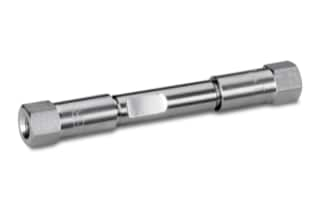
|
Chemistry |
C4 |
|
Separation Mode |
Reversed Phase |
|
Particle Substrate |
Silica |
|
pH Range Min |
2 pH |
|
pH Range Max |
8 pH |
|
Maximum Pressure |
6000 psi (415 Bar) |
|
Endcapped |
Yes |
|
Silanol Activity |
Low |
|
Molecular Weight Range Min |
1000 |
|
Molecular Weight Range Max |
30000 |
|
Particle Shape |
Spherical |
|
Particle Size |
3.5 µm |
|
Endfitting Type |
Waters |
|
Pore Size |
300 Å |
|
Format |
Column |
|
Surface Area |
110 |
|
System |
HPLC |
|
USP Classification |
L26 |
|
Inner Diameter |
4.6 mm |
|
Length |
50 mm |
|
Carbon Load |
2.8 % |
|
UNSPSC |
41115709 |
|
Application |
Protein |
|
Brand |
Symmetry |
|
Product Type |
Columns |
|
Units per Package |
1 pk |

Symmetry C4 Column, 300Å, 3.5 µm, 4.6 mm X 50 mm, 1K - 30K, 1/pk
With the Symmetry C4 Column, you can trust in the long-term compliance of your HPLC procedures. It was created to set the benchmark for HPLC drug testing. The lab equipment enables vital analysis to be performed without sacrificing peak shape, selectivity, column-to-column and batch-to-batch consistency, or other important performance features. The wide-pored, reversed-phase Symmetry C4 Column is a popular choice in the pharmaceutical business because of its sensitive, robust, and rough HPLC testing. Its C4 chemistry lends itself well to big peptides and proteins.
The Symmetry C4 Column will outperform other columns in high and low mass circumstances. For mass spectrometry applications, low TFA mobile phases or 0.1% formic acid are advised. Regardless of whether or where the method is used, the analytical column provides the finest answer for validation compliance. When compared to conventional columns of similar chemistry, the Symmetry C4 Column provides improved peak shape and peak capacity for the separation of physiologically active peptides. The Symmetry C4 Column outperforms other columns when it comes to separating hydrophilic and hydrophobic peptides, as well as neutral and highly basic peptides.
The Symmetry C4 Column provides the sharpest peaks for biomolecules as well as increased peak capacity for complicated tryptic maps. This is made feasible by the use of ultrapure silica that is produced. The end result is a high-purity analytical column with very low silanol activity. The column is additionally packed to provide the highest efficiency and reproducibility of any product on the market, providing you with better precision for impurity and stability tests, more accurate quantitation, and adaptation to more challenging procedures.
Browse our brochure or visit our website to quickly shop for lab equipment that meets the needs of your laboratory. You might also be interested in Reversed-Phase QC Reference Material. The Reversed-Phase QC Reference Material is a highly complicated reference material mixture that comprises components that may be difficult to separate. It is intended to give this complexity and is suited for routinely performing difficult experiments. It is compatible with a wide range of column chemistries and dimensions, as well as system hardware.
What May Cause Your LC System To Shut Down?
Overpressure protection is included in HPLC pumps and systems to ensure system safety and to protect the columns and equipment. The pump may shut off to protect the LC system if the system is set too low or there is too much backpressure. Other explanations could include cleaning the lines or eliminating residual or crystallized material that is obstructing or choking the system.